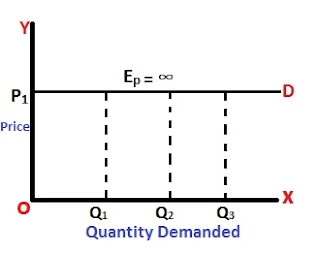Price elasticity of demand (PED or Ed or Ep)
Price elasticity of demand is defined as a measure which shows the responsiveness or elasticity of the quantity demanded of a good or services to a change in price, ceteris paribus (Other things being constant). More precisely, it is the ratio of the percentage change in quantity demanded in response to a 1% change in price.Ep = Percentage Change in Quantity Demanded / Percentage Change in Price
Where,
∆P=Change in price
∆Q=Change in quantity demanded
P=Initial price
Q=Initial quantity
Types/Degrees of Price Elasticity of demand
1. Perfectly elastic demand (Ep=∞)
When a small change in the price of a commodity causes a major change in its demand then it is said to be perfectly elastic demand. A small fall in price increases to infinity and a negligible rise in price decreases demand drastically in this type of elasticity. It is rarely found in practical life.In the above figure, P1D represents a perfectly elastic demand curve which is parallel to the x-axis. It shows that at price OP1 quantity demanded may be OQ1, OQ2, or OQ3.
2. Perfectly inelastic demand (Ep=0)
When a certain change in price does not affect the quantity demanded of a commodity, then the demand curve is said to be perfectly inelastic. E.g. necessary goods like salt medicine etc.In the above figure, Q1D is perfectly inelastic demand. It is parallel to the y-axis. It shows that at price OP1, OP2, OP3, the quantity demanded remains unchanged. I.e.OQ1
3. Unitary elastic demand (Ep=1)
If the percentage change in demand is equal to the percentage change in the price of goods, then the demand is known as unitary elastic demand, e.g. when price increases by 10%, then demand also decreases by 10%.In the above figure price and quantity are shown along y-axis and x-axis respectively. DD represents the demand curve which is unitary elastic. I.e. equal to 1
4. Relatively elastic demand (Ep>1)
If the change in quantity demanded is greater than the change in price, then the demand is said to be relatively elastic. E.g. luxurious goods like LED, cars, mobiles, etc.In the above figure price and quantity are shown along y-axis and x-axis respectively. When price changes from P1 to P2 then, quantity demanded changes from Q1 to Q2 but by a greater proportion than price. The demand curve DD is relatively elastic. I.e. Ep > 1.
5. Relatively inelastic demand (Ep<1)
If the quantity demanded changes in less proportion or less percentage than the percentage change in price, then it is the case of relatively inelastic demand. Here, the absolute value of price elasticity of demand is always less than 1.In the above figure price and quantity are shown along y-axis and x-axis respectively. When price changes from P1 to P2 then, quantity demanded also changes from Q1 to Q2 but by less proportion than price. The demand curve DD is relatively inelastic. I.e. Ep < 1.







0 Comments
If this article has helped you, please leave a comment.